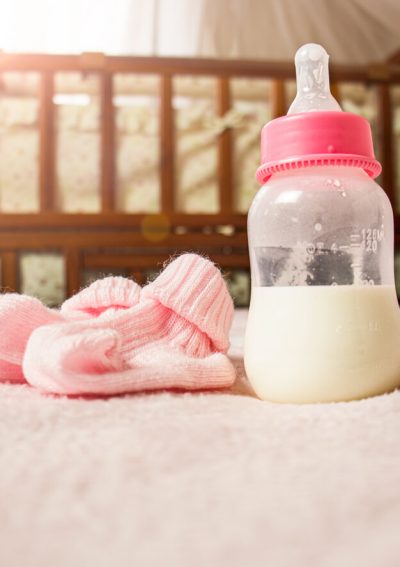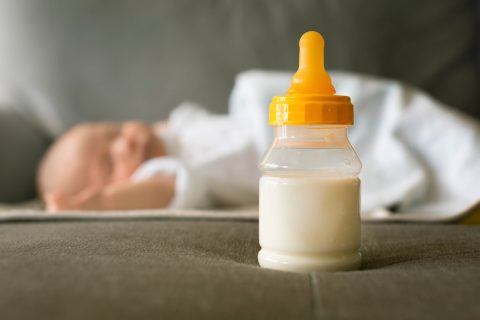Baby Formula
Baby formula is a specially designed breast milk substitute that provides essential nutrients for infants. Formula meets specific dietary needs and sensitivities but requires careful preparation and storage to prevent contamination, burns or spoilage. It comes in various forms.

What Is Baby Formula?
Baby formula is a human breast milk substitute containing the nutritional elements infants under 12 months of age need to grow and develop. These elements include proteins, carbohydrates, fats, vitamins and minerals.
Formula is often necessary because many new parents cannot provide enough nutrition to their baby through nursing alone. It is available as a powder, concentrated liquid or ready-to-use liquid.
Types of Baby Formulas
While most formula-fed newborns drink cow’s milk formulas, other options are available. There are differences between each formula type, but they all include the nutrients infants require to grow.
- Cow’s Milk Formulas: This is the most common type of dairy formula. It contains lactose, vegetable oils, vitamins and minerals that are essential for babies.
- Goat’s Milk Formulas: Infants might tolerate goat’s milk formulas better than cow’s milk formulas. However, it is an unsuitable alternative for babies with a cow’s milk allergy.
- Hypoallergenic Formulas: Babies who have trouble digesting milk protein or are allergic to standard formula may need these extensively hydrolyzed or amino acid-based formulas. Hydrolyzed formulas have partially broken down proteins, making them easier to digest.
- Lactose-Free Formulas: Doctors recommend modified cow’s milk formula for babies who are lactose intolerant.
- Soy-Based Formulas: Soy formula is a generally healthy alternative, especially for babies with a hereditary condition called galactosemia that prevents them from breaking down the proteins and sugars in cow’s milk.
- Special Health Problem Formulas: Pediatricians often direct parents of premature babies or babies with low birth weight to use specialized formulas. Babies with digestive problems, reflux or heart disease may also benefit from special formulas.
The three main types of formula are cow’s milk, soy and hypoallergenic. Regardless of which one you choose, opting for an iron-fortified formula can be beneficial.
How To Choose the Right Baby Formula
All commercial formulas meet standard nutritional requirements, but the best formula for your infant depends on their age, weight, food sensitivities and other medical needs. Talk to your child’s pediatrician before starting or changing your baby’s formula.
A comprehensive global survey published in the British Medical Journal in February 2023 evaluated infant formula products’ health and nutrition claims.
The findings revealed that most products had at least one benefits-related claim. However, many claims were not backed by strong scientific evidence. The authors worry that these claims could make people think that formula is better than breastfeeding, which could affect mothers’ choices.
Your baby may not be on the right formula if they aren’t gaining weight or are very fussy, constipated, spitting up excessively or experiencing bloody stools. Some babies are also allergic to certain formulas and may develop rashes, swelling or other symptoms.
If your baby experiences any of these issues, speak to your doctor immediately to get them on the right formula.
Baby Formula Feeding Information
When starting formula feeding, you can use plastic, stainless steel, disposable or glass bottles and the appropriate nipple size for your baby’s age. A newborn should have the slowest flow nipple.
Follow the directions on the formula’s label. Use the required amount of water and the scoop provided to ensure the correct ratio of powder formula to water.
It’s advisable to use liquid (concentrated or ready-to-feed) formula for infants who are at risk of infection, immunocompromised, premature or younger than two months.
-
Newborn
Offer your newborn one to two ounces of formula every two to three hours.
-
Two to Five Months
As they grow, infants can drink more at each feeding, allowing you to stretch feeding times to every three to four hours.
-
Six to 12 Months
Feed your baby when they’re hungry. Babies at this age eat up to six times a day and require less formula as they start eating more solid food.
-
12 to 24 Months
You can gradually replace the formula with whole cow’s milk or fortified unsweetened soy milk.
It’s normal for feeding habits to fluctuate with changes like teething or growth spurts. Every baby is different, so follow your infant’s cues and guidance from their pediatrician.
Baby Formula Safety Information
A study published in Frontiers in Pediatrics investigated the risks of burn injuries in babies caused by hot water used to prepare powdered infant formula.
Although the number of burns directly connected to making formula was not high, the study emphasized the importance of providing clear guidance for preparation. Guidance should focus on avoiding bacteria and on preventing burns from hot water.
Follow package instructions and use safe practices when preparing your baby’s formula. Ensure bottles are clean and sanitized.
If you use powdered infant formula, using bottled or clean tap water is recommended. Many experts suggest heating water to at least 158 degrees Fahrenheit and letting it cool for no more than 30 minutes before preparing the formula.
For your child’s safety, use any prepared formula within two hours of preparation or store it in the refrigerator and use it within 24 hours. You can store the open container in your fridge for 48 hours for ready-to-feed formulas.
Keep unopened powdered formula in a cool place. You should use opened formulas within a month of opening. Never use formula past its “use by” date.
Experts suggest avoiding homemade formula. Making formula at home can leave out essential nutrition for your baby.
Regulatory Safety Oversight of Baby Formula
In August 2023, the FDA provided a significant update on its initiatives to enhance the safety of infant formula.
As part of these efforts, the agency conducted 47 inspections of formula production facilities to ensure compliance with safety standards. The FDA issued warning letters to three infant formula manufacturers (Mead Johnson Nutrition, ByHeart Inc. and Perrigo Wisconsin, LLC) that were not meeting safety requirements.
To further educate the public, the agency expanded its educational materials focused on the risks associated with Cronobacter sakazakii, emphasizing the importance of formula safety for infants.
What Are the Risks of Baby Formula Feeding?
The risks of baby formula feeding can include bacterial contamination, allergic reactions and gastrointestinal problems.
Contamination is more likely with imported formulas subjected to less regulation and oversight. For example, researchers found antibiotic-resistant bacteria strains Enterobacteriaceae and Enterococcus in formulas manufactured in Chile and Mexico. These harmful products pose a significant health risk to infants.
Cow’s milk allergies can occur in infants and young children. Babies might be allergic to the milk proteins casein, whey or both. A milk allergy is different from lactose intolerance. Symptoms of an allergic reaction include raised red bumps, eczema, digestive problems and a runny nose or itchy eyes.
Recent studies also identified a link between a severe gastrointestinal problem and premature babies on baby formula. The condition is called necrotizing enterocolitis (NEC). Families have filed several baby formula lawsuits because of this link. However, this link is still being debated in court, and the formula is unlikely to harm full-term, healthy babies.
Why Was There a Baby Formula Shortage?
A voluntary recall from Abbott on February 17, 2022, led to a baby formula shortage. Recalled formulas included Similac, Alimentum and EleCare. Abbott ordered the recall after four consumer complaints related to Cronobacter sakazakii and Salmonella Newport.
The U.S. Food and Drug Administration commissioner further attributed formula shortages in certain locations to “distribution inefficiencies.”
Preventing Future Shortages
Since Abbott’s 2022 baby formula recall, the FDA has taken steps to prevent baby formula shortages from happening again. The agency has been checking local and international formula production facilities more often and updated its protocols to prevent Cronobacter sakazakii infections.
To help ensure a steady supply, the FDA has simplified importing formulas from new suppliers by easing import rules and temporarily lowering taxes on these products. It also established new methods to handle customer complaints and whistleblower reports and created a special office focused on overseeing baby formula.
Additionally, the FDA is working with health agencies and outside researchers to improve its long-term plans for ensuring a reliable supply of baby formula.
Editor Lindsay Donaldson contributed to this article.
32 Cited Research Articles
Consumernotice.org adheres to the highest ethical standards for content production and references only credible sources of information, including government reports, interviews with experts, highly regarded nonprofit organizations, peer-reviewed journals, court records and academic organizations. You can learn more about our dedication to relevance, accuracy and transparency by reading our editorial policy.
- U.S. Food and Drug Administration. (2025, January 10). Infant Formula. Retrieved from https://www.fda.gov/food/resources-you-food/infant-formula
- Mayo Clinic. (2024, December 20). Infant Formula: 7 Steps to Prepare It Safely. Retrieved from https://www.mayoclinic.org/healthy-lifestyle/infant-and-toddler-health/in-depth/infant-formula/art-20045791
- U.S. Judicial Panel on Multidistrict Litigation. (2024, November 1). MDL Statistics Report. Retrieved from https://www.jpml.uscourts.gov/sites/jpml/files/Pending_MDL_Dockets_By_Actions_Pending-November-1-2024_0.pdf
- U.S. Food and Drug Administration. (2024, August 20). Status Update on FDA’s Infant Formula Response Activities. Retrieved from https://www.fda.gov/food/infant-formula-guidance-documents-regulatory-information/status-update-fdas-infant-formula-response-activities
- Hill, J. (2024, July 7). Nutrition Companies, Parents Clash in Court Over Cause of Infant Intestinal Disease. Retrieved from https://abcnews.go.com/US/nutrition-companies-parents-clash-court-cause-infant-intestinal/story?id=111617194
- U.S. Centers for Disease Control and Prevention. (2024, March 5). About Feeding From a Bottle. Retrieved from https://www.cdc.gov/infant-toddler-nutrition/bottle-feeding/index.html
- Cheung, K.Y., et al. (2024, February 15). Health and Nutrition Claims for Infant Formula: International Cross-Sectional Survey. Retrieved from https://www.bmj.com/content/380/bmj-2022-071075
- Alberta Health Services. (2024, January 9). Nutrition Guideline Healthy Infants and Young Children Safe Preparation and Handling of Infant Formula. Retrieved from https://www.albertahealthservices.ca/assets/info/nutrition/if-nfs-ng-healthy-infants-infant-formula-safe-preparation-handling.pdf
- Pitone, M. (2024, January). Formula Feeding FAQs: Preparation and Storage. Retrieved from https://kidshealth.org/en/parents/formulafeed-storing.html
- Fuchs, G., et. al. (2023, October 20). Choosing a Baby Formula. Retrieved from https://www.healthychildren.org/English/ages-stages/baby/formula-feeding/Pages/choosing-an-infant-formula.aspx
- Harris, N. (2023, May 20). How to Choose the Right Bottle Nipple Size and Flow Level. Retrieved from https://www.parents.com/baby/feeding/bottlefeeding/baby-bottle-nipple-size/
- Chiang, K.v. (2023, May 4). Infant Burn Injuries Related to Water Heating for Powdered Infant Formula Preparation. Retrieved from https://pmc.ncbi.nlm.nih.gov/articles/PMC10192855/
- Mount Sanai. (2023, April 25). Buying and Caring for Baby Bottles and Nipples. Retrieved from https://www.mountsinai.org/health-library/special-topic/buying-and-caring-for-baby-bottles-and-nipples
- University of Florida Health. (2023, April 25). Infant Formulas. Retrieved from https://ufhealth.org/conditions-and-treatments/infant-formulas
- Para-Flores, J., et. al. (2022, November 8). Are Enterobacteriaceae and Enterococcus Isolated From Powdered Infant Formula a Hazard for Infants? a Genomic Analysis. Retrieved from https://pmc.ncbi.nlm.nih.gov/articles/PMC9689349/
- Lee, M.j. (2022, October 21). Q&a: The Head of the FDA Answers Why Parents Are Still Struggling to Find Baby Formula and When Things Might Return to Normal. Retrieved from https://www.cnn.com/2022/10/21/politics/robert-califf-q-and-a/index.html
- Simon, S. (2022, October 21). Baby Formula Lawsuit Update December 2022. Retrieved from https://www.forbes.com/advisor/legal/product-liability/baby-formula-lawsuit/
- Jones, D. (2022, September 23). Here’s What the FDA Says Contributed to the Baby Formula Shortage Crisis. Retrieved from https://www.npr.org/2022/09/23/1124558475/baby-formula-shortage-crisis-fda-internal-review
- U.S. Centers for Disease Control and Prevention. (2022, July 13). Infant Formula Preparation and Storage. Retrieved from https://www.cdc.gov/infant-toddler-nutrition/formula-feeding/preparation-and-storage.html?CDC_AAref_Val=https://www.cdc.gov/nutrition/infantandtoddlernutrition/formula-feeding/infant-formula-preparation-and-storage.html
- Medaris, A. (2022, May 18). An ER Doctor Says He’s Treating Infants at Risk for Life-Threatening Seizures After They Consumed Diluted Baby Formula and Urges Parents Not to Take a Risk With Homemade Versions. Retrieved from https://www.businessinsider.com/er-doc-says-watered-down-homemade-formulas-putting-infants-danger-2022-5
- U.S. Centers for Disease Control and Prevention. (2022, May 16). How Much and Often to Feed Infant Formula. Retrieved from https://www.cdc.gov/infant-toddler-nutrition/formula-feeding/how-much-and-how-often.html?CDC_AAref_Val=https://www.cdc.gov/nutrition/infantandtoddlernutrition/formula-feeding/how-much-how-often.html
- U.S. Food and Drug Administration. (2022, May 12). Powdered Infant Formula Recall: What to Know. Retrieved from https://www.fda.gov/consumers/powdered-infant-formula-recall-what-know
- Mayo Clinic. (2022, April 1). Choosing An Infant Formula. Retrieved from https://mcpress.mayoclinic.org/parenting/choosing-an-infant-formula/
- Parra-Flores, J. et al. (2022). Are Enterobacteriaceae and Enterococcus Isolated From Powdered Infant Formula a Hazard for Infants? a Genomic Analysis. Retrieved from https://www.mdpi.com/2304-8158/11/22/3556
- U.S. Department of Agriculture WIC Works Resource System. (2022). Infant Formula Recall. Retrieved from https://wicworks.fns.usda.gov/resources/infant-formula-recall
- Gavin, M, MD. (2021, November). Formula Feeding FAQs: Starting Solids and Milk. Retrieved from https://kidshealth.org/en/parents/formulafeed-solids.html
- Allergy UK. (2021, July 6). Does My Child Have a Cow’s Milk Allergy? Retrieved from https://www.allergyuk.org/resources/does-my-child-have-a-cows-milk-allergy/
- Remmel, A. (2021, January 3). What Is Infant Formula, and How Can Scientists Make It More Like Human Milk? Retrieved from https://cen.acs.org/articles/99/i1/infant-formula-scientists-make-like.html
- Lewsley, J. (2020, September). Do You Need to Boil Water Before Using It to Make Formula Milk? Retrieved from https://www.babycentre.co.uk/x1048896/do-you-need-to-boil-water-before-using-it-to-make-formula-milk
- NYC Health. (2019, December 20). Safe Formula Feeding. Retrieved from https://www.nyc.gov/assets/doh/downloads/pdf/csi/safe-formula-preparation.pdf
- Children’s Hospital of Philadelphia. (n.d.). Milk Allergies. Retrieved from https://www.chop.edu/conditions-diseases/milk-allergies
- Colgate. (n.d.). Do Baby Growth Spurts Affect the Development of Teeth? Retrieved from https://www.colgate.com/en-za/oral-health/infant-oral-care/do-baby-growth-spurts-affect-the-development-of-teeth-1014
Calling this number connects you with a Consumer Notice, LLC representative. We will direct you to one of our trusted legal partners for a free case review.
Consumer Notice, LLC's trusted legal partners support the organization's mission to keep people safe from dangerous drugs and medical devices. For more information, visit our partners page.
844-763-0072

